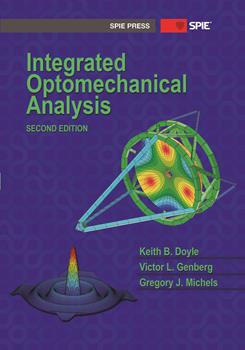|
This chapter presents methods and concepts relevant to finite element simulation of adaptive optical systems. 10.1 Introduction In an adaptive optical system, image motion and aberrations are reduced by moving and deforming one or more optical surfaces. Such adjustment may be made to compensate for temperature gradients, gravity effects, or other load conditions. Such adjustments are often made in response to a measurement of the optical performance of the system. Fig. 10.1 shows a schematic of an adaptive telescope in which aberrations caused by a turbulent atmosphere are corrected. Before reaching the image plane, some of the light is split into a wavefront sensor. Measurements from the wavefront sensor are sent to a controller that predicts how the deformable mirror should be actuated to best correct any aberrations. In such a system, the ability of the algorithm used to predict accurate control commands to best correct the induced aberrations is critical to the net optical performance. It is equally important, however, for the deformable mirror to be able to deform into shapes that will be required to correct the unwanted aberrations. Therefore, predictions of the deformable mirror's performance are of great interest to engineers designing such a system. Three common forms of adaptive mirrors discussed in the literature are shown in Fig. 10.2. Fig. 10.2(a) illustrates architecture characterized by enforced displacement actuators for motion control and an accompanying array of force actuators. The displacement actuators exhibit relatively high stiffness, and, therefore, act as mounts and a means to control the rigid body motion of the optic with high authority. The force actuators are generally low-authority implementations that deliver a desired equal and opposite force pair between two points. A relatively stiff reaction structure is used to react to the actuation loads developed during adaptive figure control. Notice that moment actuators may be implemented through the use of a force actuator and an accompanying moment arm, as shown. Fig. 10.2(b) illustrates an architecture characterized by an array of high-authority displacement actuators. The displacement actuators react against a relatively stiff reaction structure during adaptive figure control and loading of the assembly. Fig. 10.3(c) illustrates an architecture employing embedded actuators within an optic that is mounted on displacement actuators. Use of this architecture eliminates the need for a reaction structure since the actuation loads are internally reacted within the optic. The embedded actuator implementation, however, generally requires many more actuators than the two architectures illustrated by Figs. 10.2(a) and 10.2(b). |
|
|


